Another Bouncing Ball: November 2010 Archives
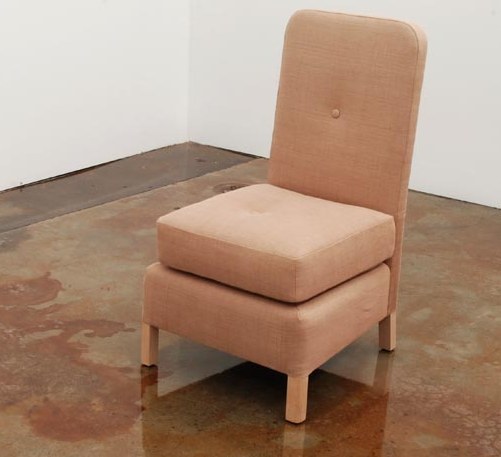 Currently at Ambach & Rice is McMakin's Five Chairs and Ten Tables, a sweet little show with a large contemplative back beat.
Currently at Ambach & Rice is McMakin's Five Chairs and Ten Tables, a sweet little show with a large contemplative back beat. Remember Alice's uncertain relationship to an occasional table? That table was what McMakin's rarely are - an innocent bystander.
 John Baldessari, whose home is full of McMakin's, described McMakin's endeavor in an essay included in Roy McMakin: When is a chair not a chair?
John Baldessari, whose home is full of McMakin's, described McMakin's endeavor in an essay included in Roy McMakin: When is a chair not a chair?A love of minimalism (while slightly poking fun at it), a Mattisean love of color, a goal of keeping others off balance, and a love of removal/absence, a quest for the paradox of simplicity and complexity. But overall, a mission to sharpen perception, it's a significant accomplishment to get one to really see and understand a chair (and not feel self-conscious in sitting on it). I don't think Roy has designed an ironing board yet, but I'm sure it would double as a painting.Michael Darling called him a "master craftsman with the heart of a conceptualist." His tables and chairs are facts with a twist of dry wit, as in the table top that doesn't quite fit its base.
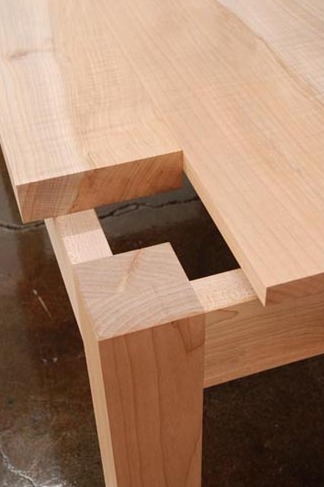 In 1965, conceptual artist Joseph Kosuth created One and Three Chairs (a photo of a chair, a chair and a dictionary description of a chair). A point of view that is austerely tough-minded in Kosuth is sweet, almost goofy in McMakin. Kosuth invites us to consider a rigorous idea by turning it over in our minds. McMakin insists on taking the body along for the ride. His work is a voluptous challenge, a reminder that, as long as we're awake, we might as well be aware, and take no chair for granted.
In 1965, conceptual artist Joseph Kosuth created One and Three Chairs (a photo of a chair, a chair and a dictionary description of a chair). A point of view that is austerely tough-minded in Kosuth is sweet, almost goofy in McMakin. Kosuth invites us to consider a rigorous idea by turning it over in our minds. McMakin insists on taking the body along for the ride. His work is a voluptous challenge, a reminder that, as long as we're awake, we might as well be aware, and take no chair for granted. Through Dec. 5.
 Looks like broccoli to me, which reminds me of E.B. White's tagline for a 1928 New Yorker cartoon drawn by Carl Rose (Image via)
Looks like broccoli to me, which reminds me of E.B. White's tagline for a 1928 New Yorker cartoon drawn by Carl Rose (Image via)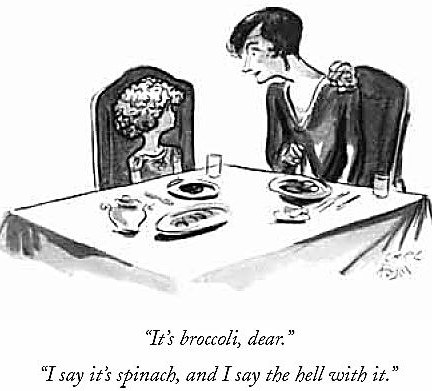 On Thanksgiving in Seattle, a pipe froze at my house and burst, just in time for a house guest, who's arriving from Portland in an hour or so. Fortunately, we are eating elsewhere, and there are buckets of snow in the bathroom for that homey historic touch. As Strauss wrote in her email:
On Thanksgiving in Seattle, a pipe froze at my house and burst, just in time for a house guest, who's arriving from Portland in an hour or so. Fortunately, we are eating elsewhere, and there are buckets of snow in the bathroom for that homey historic touch. As Strauss wrote in her email:Happy Thanksgiving to everyone. Whether you celebrate it or revile it, have a great day filled with love.Those in the market for gifts might consider Strauss' America, my favorite book from 2008, already a classic but still available on Amazon for $19.77.
VARIATIONS, 2010 Archival inkjet print 52 x 44 inches Edition of 6
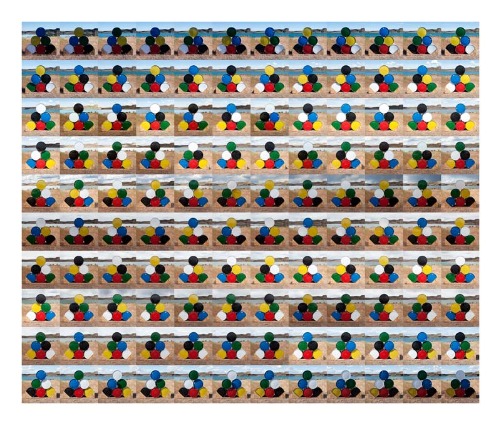 Titled Dust to Dust, the exhibit at Greg Kucera Gallery is overhung, which is a problem for an artist whose strategizing can devolve into the aridly clever. These photos need more space than they get. Like crabs in a barrel, however, the ones on top manage to hook a claw over the edge and climb out.
Titled Dust to Dust, the exhibit at Greg Kucera Gallery is overhung, which is a problem for an artist whose strategizing can devolve into the aridly clever. These photos need more space than they get. Like crabs in a barrel, however, the ones on top manage to hook a claw over the edge and climb out.EQUIVALENCE, 2009 Inkjet print 38 x 48 inches Edition of 6
 Abandoned Crates needs no back story. Into a verdant harmony, what is made by humans floats on a lake. The photo is an immaculate version of the messy masterpiece, Aguirre, the Wrath of God. (There's meat floating by...) Vanity, vanity; all is vanity.
Abandoned Crates needs no back story. Into a verdant harmony, what is made by humans floats on a lake. The photo is an immaculate version of the messy masterpiece, Aguirre, the Wrath of God. (There's meat floating by...) Vanity, vanity; all is vanity. ABANDONED CRATES, 2007 Archival inkjet print 40 x 49 inches Edition of 6
 Through Dec. 24.
Through Dec. 24.I missed her recent exhibit at G. Gibson Gallery, but Gail Gibson was kind enough to unwrap a few to show me.
From 12th Ave S., North Beacon Hill, 2010 oil on panel, 18 x 24 inches
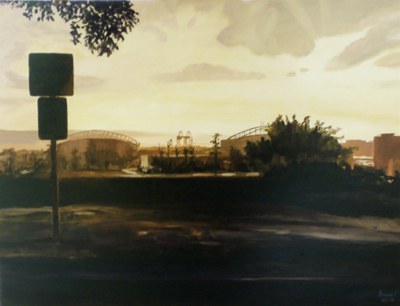 From Columbia City, 2010
oil on panel, 16 x 24 inches
From Columbia City, 2010
oil on panel, 16 x 24 inches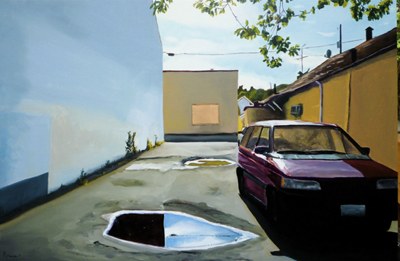
From Tieton, 2010
oil on panel, 24 x 29.5 inches
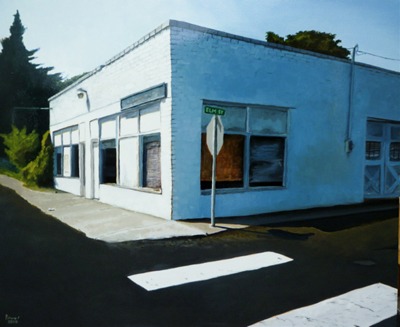 Peonies I, 2010
oil on canvas, 46 x 54 inches
Peonies I, 2010
oil on canvas, 46 x 54 inches
 Peonies I, 2010
oil on canvas, 46 x 54 inches
Peonies I, 2010
oil on canvas, 46 x 54 inches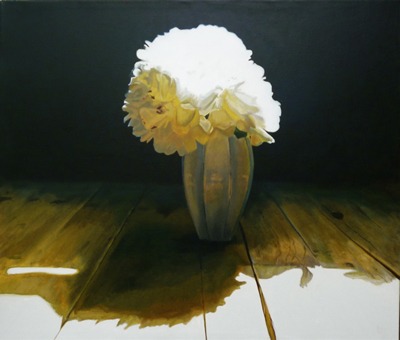
What do we want?Her videos, drawings, wallpaper, sculptures and photographs strike a deadpan note, like Buster Keaton but minus his anxiety.
Nothing!
When do we want it?
Never!
I Don't Need A Therapist, 2008 Crosstitch on linen 24" x 30 " x 1/2"
 EXIST 2009 Powder coated aluminum w/ LED lights (altered Exit sign)
7.5" x 12" x 2"
EXIST 2009 Powder coated aluminum w/ LED lights (altered Exit sign)
7.5" x 12" x 2"  Master of the laid-back she may be, but work takes work. When she wants to relax from the heavy cogitation and technical issues of doing it, she fastens a magnifying lens to her eye and hunches over a table, making interior blizzards full of press type.
Master of the laid-back she may be, but work takes work. When she wants to relax from the heavy cogitation and technical issues of doing it, she fastens a magnifying lens to her eye and hunches over a table, making interior blizzards full of press type.Twenty of these time-out, going-nowhere-fast drawings are at Platform Gallery through Saturday.
Meek 2010 Letraset on archival mat board; 19 x 24 inches(detail on the right)
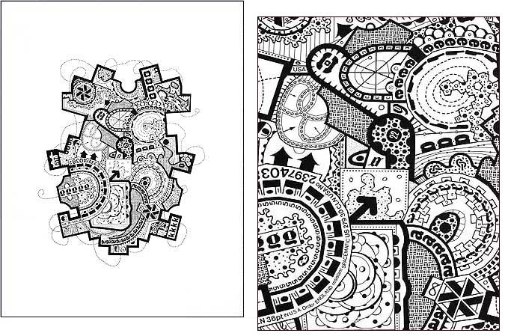
Using archival footage, Lesperance photographs sweaters worn by demonstrators and recreates them, first in yarn, second abstracted in gouache on paper. Five of these drawings hang at SAM, and they are inert: Paul Klee in a coma. What is lively in Klee's line is dead in hers. Just because she has an appealing back story doesn't mean her drawings are any good at all. Looks as if this year's Betty Bowen jurors were seduced by intent.
We Will Cover Your Fallen Body, Beth O'Brien, and Tell You That It Was Not in Vain. The Forest at Eagle Creek Remains! Let It Echo Your Most Valiant of Names: Horehound...Horehound.... 2010
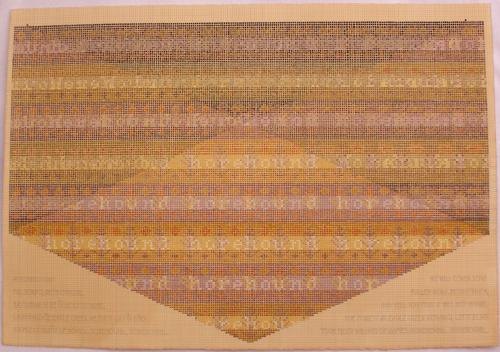
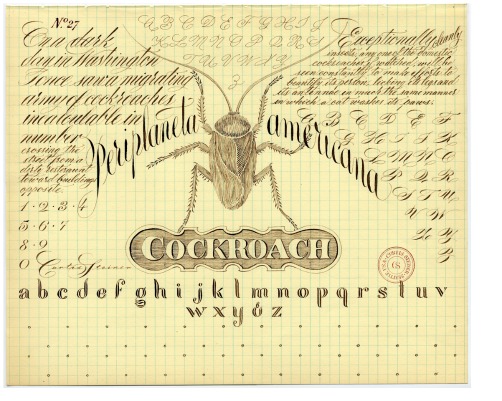 Each
insect holds court on the page, antenna twitching, surrounded by the
calligraphy known as cursive. Last year, when my nephew Rafferty was
five, he showed me a sample of his, calling it "curse writing."
("Cursive," I told him. "No," he said with a scowl, "curse
writing.")
Each
insect holds court on the page, antenna twitching, surrounded by the
calligraphy known as cursive. Last year, when my nephew Rafferty was
five, he showed me a sample of his, calling it "curse writing."
("Cursive," I told him. "No," he said with a scowl, "curse
writing.")Rafferty is a fan of Steiner's, thanks to Steiner's interactive project at the Seattle Art Museum titled, 1,000 Blocks.(Steiner's manipulations here.) Steiner's arrangements are top hat and tail; Rafferty's are dockworker, blocks roughing each other up in muscled heaps.
Steiner's interest in lists of things is not so nearly extinct as his fine hand. The urge to categorize and define animates the work of his polar opposite, Gregory Blackstock, who from memory draws images he has seen in dictionaries, encyclopedias and other source books, starting with outlines and shading in. Each of his drawings is a list, and the paper is often cut and taped together into a kind of scroll, punctuated by block writing.
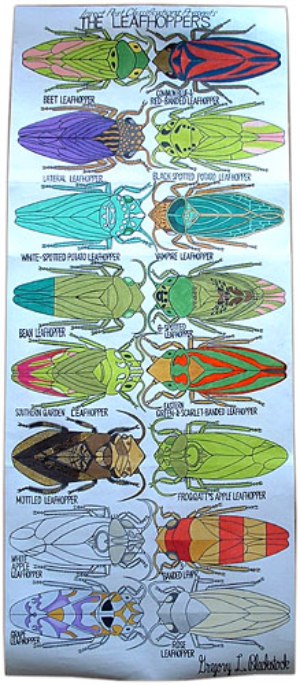 We
inhabit the world by naming its parts. In times of upheaval, names blur
and opposites stand in for each other, perfectly illustrated in 1942 by
Henry Reed, whose mind in the middle of World War II productively wandered between sex
and death.
We
inhabit the world by naming its parts. In times of upheaval, names blur
and opposites stand in for each other, perfectly illustrated in 1942 by
Henry Reed, whose mind in the middle of World War II productively wandered between sex
and death.NAMING OF PARTS
To-day we have naming of parts. Yesterday,
We had daily cleaning. And to-morrow morning,
We shall have what to do after firing. But to-day,
To-day we have naming of parts. Japonica
Glistens like coral in all of the neighboring gardens,
And to-day we have naming of parts.
This is the lower sling swivel. And this
Is the upper sling swivel, whose use you will see,
When you are given your slings. And this is the piling swivel,
Which in your case you have not got. The branches
Hold in the gardens their silent, eloquent gestures,
Which in our case we have not got.
This is the safety-catch, which is always released
With an easy flick of the thumb. And please do not let me
See anyone using his finger. You can do it quite easy
If you have any strength in your thumb. The blossoms
Are fragile and motionless, never letting anyone see
Any of them using their finger.
And this you can see is the bolt. The purpose of this
Is to open the breech, as you see. We can slide it
Rapidly backwards and forwards: we call this
Easing the spring. And rapidly backwards and forwards
The early bees are assaulting and fumbling the flowers:
They call it easing the Spring.
They call it easing the Spring: it is perfectly easy
If you have any strength in your thumb: like the bolt,
And the breech, and the cocking-piece, and the point of balance,
Which in our case we have not got; and the almond-blossom
Silent in all of the gardens and the bees going backwards and forwards,
For to-day we have naming of parts.
From The Love Song of J. Alfred PrufrockImage (part of a series titled Shanghai Expo), comes from Marsha Burns' daily photo stream, which she sends to a fortunate few via email. There is no other way of seeing it. You have to know her.
T.S. Eliot
And indeed there will be time
To wonder, "Do I dare?" and, "Do I dare?"
Time to turn back and descend the stair,
With a bald spot in the middle of my hair --
[They will say: "How his hair is growing thin!"]

There are, of course, other poses to strike on the way to the exit. I saw an elderly man walking with brisk good cheer around Green Lake wearing a t-shirt with the legend, "Don't trust anyone under 70." Andrew Marvell didn't want to last that long. He was an early advocate of an attitude best known today as The Who's My Generation (Hope I Die Before I Get Old). Too bad Keith Moon didn't live long enough to hear The Zimmers sing his band's most famous song. Their effort might have slowed down his forward hurtle. Then again, maybe not.
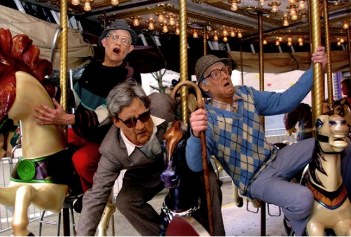
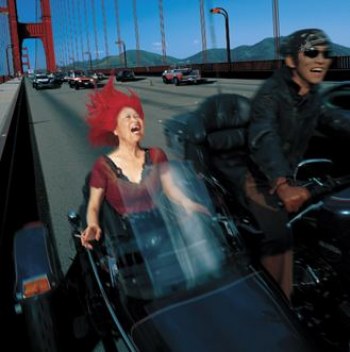
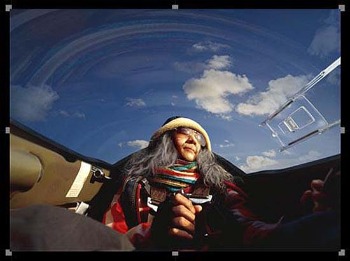
From Marvell's To His Coy MistressSpeaking of making the sun run, here's, first, SuttonBeresCuller's Merrry Go Round and second, Miwa Yanagi's Grandma and Mineko.
Now therefore, while the youthful hue
Sits on thy skin like morning dew,
And while thy willing soul transpires
At every pore with instant fires,
Now let us sport us while we may,
And now, like amorous birds of prey,
Rather at once our time devour
Than languish in his slow-chapt power.
Let us roll all our strength and all
Our sweetness up into one ball,
And tear our pleasures with rough strife
Thorough the iron gates of life:
Thus, though we cannot make our sun
Stand still, yet we will make him run.



When I think of ripe and juicy, Marilyn Minter comes to mind, and John Currin. I like my ripe in the edge of rotten: leaves in the fall, not early blooms in the spring. For hard core still life, nobody beats the 17th Century Dutch, although in France Chardin achieved a mournful reply, his simplicities achieving a depth to rival Vermeer's. In the 20th Century, Morandi in Italy stands above everyone else. Pop art is not juicy, but Wayne Thiebaud's cupcakes in San Francisco staked a claim to the quality and brought it home. Luscious and moist, they are nevertheless billboard-style streamlined.
Curated by Katie Kresser, Ripe comes down firmly on the side of subject matter instead of execution. Since my understanding of art reverses the two, there is much here that is not up my alley. By my lights, Natalie St. Martin is a botanical illustrator. Her fruit are ripe, but her delivery is dry. Gregory Jacobsen paints messes, yet the mess is disengaged. Steve Levin specializes in fussy excess. The gooey riot of his forms is sterilized by his delivery.
I didn't see Zack Bent's video, not being aware that it's only on view 1 to 3 p.m. Don't let the sign in the gallery give false hope. It claims a gallery attendant will be able to produce a key to trigger operation, which ain't necessarily so.
Christian van Minnen deserves to be in an exhibit of this title, but unfortunately, he seems to be poised in the middle of a difficult transition. His strengths include a Medieval sense of form and a ghoulish intensity to his delicate paint handling. Recently, however, reactionary Pop elements have reared their ugly heads.
In Uvas, the Peter Max-like rainbow and stars shooting out of the head of the figure made of dusty, translucent grapes does it no favors.
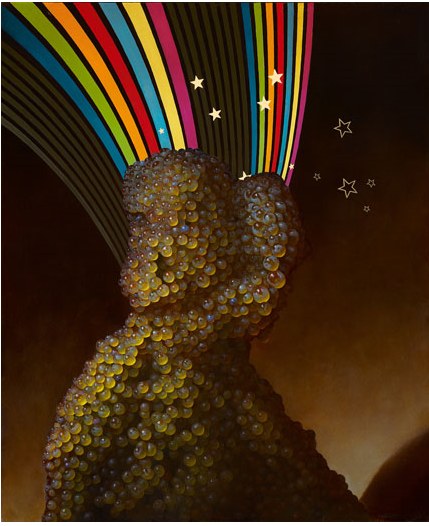 Ditto the Valentine heart and comic-strip butterflies in Hearthead.
Ditto the Valentine heart and comic-strip butterflies in Hearthead.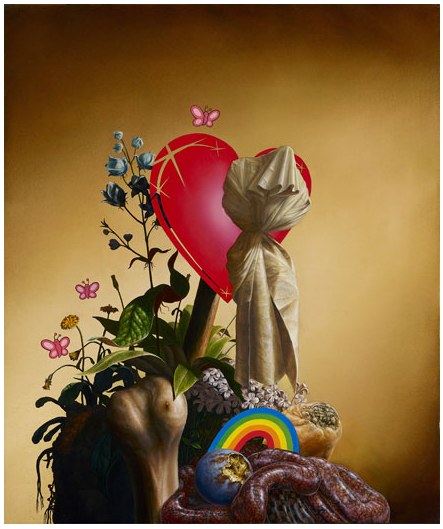 His fabulous intestinal snake protrusion at the painting's lower right, however, highlights what is wrong with Jacobsen's work. Like van Minnen, Jacobsen glamourizes rot. Rot is Jacobsen's subject, but his execution does not grip the subject. His work is a map to a place instead of place.
His fabulous intestinal snake protrusion at the painting's lower right, however, highlights what is wrong with Jacobsen's work. Like van Minnen, Jacobsen glamourizes rot. Rot is Jacobsen's subject, but his execution does not grip the subject. His work is a map to a place instead of place.Linda Hutchins' real jade plant sewn into a transparent organza shroud is lovely. As in the Biblical promise, that every hair is counted, every leaf is honored.
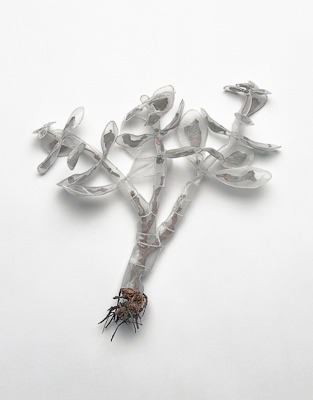 That leaves Eric Elliott. The space in his paintings is a contagion. It sticks to leaves and cramps their
blooms, which press powerfully back, holding their own. He animates
sludge, which is no small thing.
That leaves Eric Elliott. The space in his paintings is a contagion. It sticks to leaves and cramps their
blooms, which press powerfully back, holding their own. He animates
sludge, which is no small thing.Through Dec. 3.
Public personalities are paid to snap, crackle and pop. Curated by Sara Krajewski, Harry Shearer's The Silent Echo Chamber at the Henry Gallery presents them as they wait for the go light and the text prompt. They sit in their seats with nothing to do and no one to share it with.
 Surrounded by dead air, they slump and grow slack. I'd love to see Shearer's video series paired with Walker Evans' subway photos from the late 1930s and early 1940s. Concealing his camera, he took pictures of people who hadn't bothered to arrange themselves for presentation, even to themselves.
Surrounded by dead air, they slump and grow slack. I'd love to see Shearer's video series paired with Walker Evans' subway photos from the late 1930s and early 1940s. Concealing his camera, he took pictures of people who hadn't bothered to arrange themselves for presentation, even to themselves. Walker Evans, image via
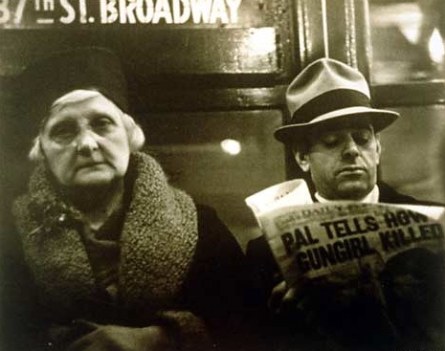 Another kind of dead air inhabits SuttonBeresCuller's project with the title, Panoptos, taken from panoptic, which means a single, clarifying view. I'd like to think that the horror here is conscious. Alas, listening to the artists hold forth and reading curator Krajewski's brochure, I fear a sunny-side-up intent.
Another kind of dead air inhabits SuttonBeresCuller's project with the title, Panoptos, taken from panoptic, which means a single, clarifying view. I'd like to think that the horror here is conscious. Alas, listening to the artists hold forth and reading curator Krajewski's brochure, I fear a sunny-side-up intent. Panoptos is an interactive installation with 150 works taken from the Henry's collections that cover the walls, not salon style as much as storage. The lighting is bad, and there is no information about any of the artists, including even their names. Making matters worse is a long vertical apparatus with an LED light that travels in front of everything on view, offering a final and fatal distraction.
Looking gets the audience nowhere. To see what's allegedly there, they have to leave the gallery and proceed down the hall, where they can operate a joy stick to focus on individual works, again, with no information.
Museums are where we go to see originals. If we want to see reproductions, we can stay at home. The 150 artworks are thus negated to the apparent pleasure of the curator, who is charged with their care.
I can't think of a more disrespectful show since Marcel Duchamp's Mile of String in 1942. Asked to participate in a Surrealism retrospective, he draped everyone else's work in string. Duchamp, of course, intended the insult. Do SuttonBeresCuller? Does it matter? Reverse what they say their intentions are and we've got a winner. Either way, I'm on the side of the 150 artworks. From Duchamp to the Seattle trio, subverting the art of others leaves a sour taste.
Online image captures from Panoptos here. So what? What's lost in these captures is everything.
Jen Graves decried these choices, calling them "devastatingly conservative." I'm tempted to say that by her reasoning, the fascinating people at parties are the ones who wear lamp shades and dance on tables, but I want to take the question of innovation more seriously.
Yes, neither Berk nor Livingston is Bruce Nauman. Neither has redrawn the map of contemporary art practice. But doing so is not any artist's job. Impact is determined by others, by their own dim or bright lights. Collectively, based on a necessarily incomplete idea of who's out there doing what, art history is made and remade.
What artist choose is the arena of their engagement. Innovators are those who make their visual thinking tangible and extend it, each piece a part of an internal symposium brought to light. In a consumer culture, where the new is not a shock but an economic imperative, the most innovative act might be steadfast loyalty to the depths and nuances of a single point of view.
Leo Saul Berk Spider Hole, detail, at Lawrimore Project
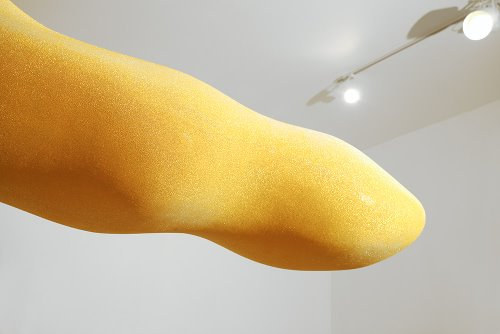 Margie Livingston at Greg Kucera
Margie Livingston at Greg Kucera
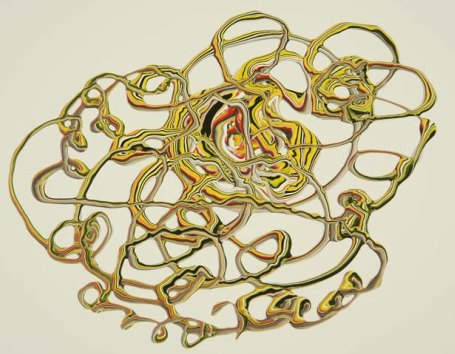 Congratulations to both artists, the Chihulys for their generosity to other artists, and to Artist Trust.
Congratulations to both artists, the Chihulys for their generosity to other artists, and to Artist Trust.
Leo Saul Berk Spider Hole, detail, at Lawrimore Project
 Margie Livingston at Greg Kucera
Margie Livingston at Greg Kucera Congratulations to both artists, the Chihulys for their generosity to other artists, and to Artist Trust.
Congratulations to both artists, the Chihulys for their generosity to other artists, and to Artist Trust.
November 16, 2010 9:22 AM
| Permalink
|
Onward to blunders: In New York last month, I imagined time spread out before me like Wallace Shawn's dinner with Andre. Instead, thanks to an infection I insisted on ignoring (mind over bacterial matter), time contracted into fast food. As an adult, I have never been in New York for as long and seen less. A few things, however, stick with me.
Kara Walker at the Museum of Modern Art: Gone, An Historical Romance of a Civil War as it Occurred between the Dusky Things of One Young Negress and Her Heart 1994 (Images via)
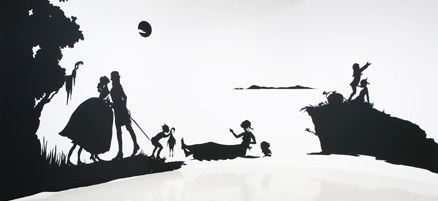
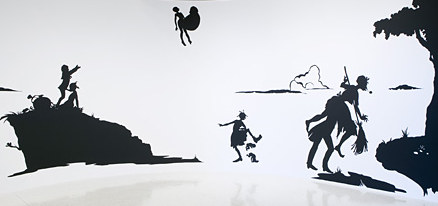 On a wide, white atrium wall, her cut-out silhouettes had the space and time they needed to make a world. It's a world inside the world, where, as Henry Miller once put it, "chaos is the score on which reality is written." After more than a decade of international prominence, she continues to weasel out with sinister exuberance the crazed core of her American experience.
On a wide, white atrium wall, her cut-out silhouettes had the space and time they needed to make a world. It's a world inside the world, where, as Henry Miller once put it, "chaos is the score on which reality is written." After more than a decade of international prominence, she continues to weasel out with sinister exuberance the crazed core of her American experience.Gone, An Historical Romance is a deliberate misreading of texts, chiefly Gone With The Wind. Her Surrealism comes to her as naturally as breathing. She reveals what is tricked-out about the movement, past and present. She does not have to struggle to inhabit a molten core. It's hers already.
Doug + Mike Starn, Big Bambu: You Can't, You Don't, You Won't Stop, on the rooftop at the Met, through October.
They should have called it Beavers in the Sky. Busy, busy, busy. While it was fun to climb through bamboo 50 feet in the air to regard the Manhattan skyline, the payoff was what's there already. Franz Kline had it right. The wonder is the architecture in the surround. The Starns worked too hard for little result. Bring back the photos.
50 Years of Pace Gallery: What can money, power and brains buy a gallery? Plenty. Three shows in four locations constituted a solid survey of the enterprise's best and brightest.
Also: Joan Snyder at Betty Cunningham (luscious lips and leaky blooms); Robert Gober at Matthew Marks (feet clogging his drains); the sign on Jim Kempner's office door (Disturb!); Five Decades of Judy Pfaff at Ameringer McEnery Yohe (The Starns needed to see this show. Unlike them, she knows how to make an excess of material into an essential), and Bing Wright at Paula Cooper (a spare tribute to the alchemical magic of a dying, silver-based medium).
Antibiotics, take a bow.
Tobias Wong

About
Blogroll
AJ Blogs
AJBlogCentral | rssculture
About Last Night
Terry Teachout on the arts in New York City
Terry Teachout on the arts in New York City
Artful Manager
Andrew Taylor on the business of arts & culture
Andrew Taylor on the business of arts & culture
blog riley
rock culture approximately
rock culture approximately
critical difference
Laura Collins-Hughes on arts, culture and coverage
Laura Collins-Hughes on arts, culture and coverage
Dewey21C
Richard Kessler on arts education
Richard Kessler on arts education
diacritical
Douglas McLennan's blog
Douglas McLennan's blog
Dog Days
Dalouge Smith advocates for the Arts
Dalouge Smith advocates for the Arts
Flyover
Art from the American Outback
Art from the American Outback
lies like truth
Chloe Veltman on how culture will save the world
Chloe Veltman on how culture will save the world
Life's a Pitch
For immediate release: the arts are marketable
For immediate release: the arts are marketable
Mind the Gap
No genre is the new genre
No genre is the new genre
Performance Monkey
David Jays on theatre and dance
David Jays on theatre and dance
Plain English
Paul Levy measures the Angles
Paul Levy measures the Angles
Real Clear Arts
Judith H. Dobrzynski on Culture
Judith H. Dobrzynski on Culture
Rockwell Matters
John Rockwell on the arts
John Rockwell on the arts
State of the Art
innovations and impediments in not-for-profit arts
innovations and impediments in not-for-profit arts
Straight Up |
Jan Herman - arts, media & culture with 'tude
Jan Herman - arts, media & culture with 'tude
dance
Foot in Mouth
Apollinaire Scherr talks about dance
Apollinaire Scherr talks about dance
Seeing Things
Tobi Tobias on dance et al...
Tobi Tobias on dance et al...
jazz
Jazz Beyond Jazz
Howard Mandel's freelance Urban Improvisation
Howard Mandel's freelance Urban Improvisation
ListenGood
Focus on New Orleans. Jazz and Other Sounds
Focus on New Orleans. Jazz and Other Sounds
Rifftides
Doug Ramsey on Jazz and other matters...
Doug Ramsey on Jazz and other matters...
media
Out There
Jeff Weinstein's Cultural Mixology
Jeff Weinstein's Cultural Mixology
Serious Popcorn
Martha Bayles on Film...
Martha Bayles on Film...
classical music
Creative Destruction
Fresh ideas on building arts communities
Fresh ideas on building arts communities
The Future of Classical Music?
Greg Sandow performs a book-in-progress
Greg Sandow performs a book-in-progress
Overflow
Harvey Sachs on music, and various digressions
Harvey Sachs on music, and various digressions
PianoMorphosis
Bruce Brubaker on all things Piano
Bruce Brubaker on all things Piano
PostClassic
Kyle Gann on music after the fact
Kyle Gann on music after the fact
Sandow
Greg Sandow on the future of Classical Music
Greg Sandow on the future of Classical Music
Slipped Disc
Norman Lebrecht on Shifting Sound Worlds
Norman Lebrecht on Shifting Sound Worlds
The Unanswered Question
Joe Horowitz on music
Joe Horowitz on music
publishing
book/daddy
Jerome Weeks on Books
Jerome Weeks on Books
Quick Study
Scott McLemee on books, ideas & trash-culture ephemera
Scott McLemee on books, ideas & trash-culture ephemera
theatre
Drama Queen
Wendy Rosenfield: covering drama, onstage and off
Wendy Rosenfield: covering drama, onstage and off
visual
Aesthetic Grounds
Public Art, Public Space
Public Art, Public Space
Another Bouncing Ball
Regina Hackett takes her Art To Go
Regina Hackett takes her Art To Go
Artopia
John Perreault's art diary
John Perreault's art diary
CultureGrrl
Lee Rosenbaum's Cultural Commentary
Lee Rosenbaum's Cultural Commentary
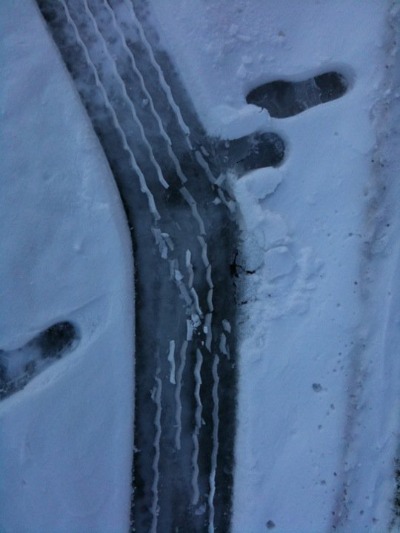

Recent Comments